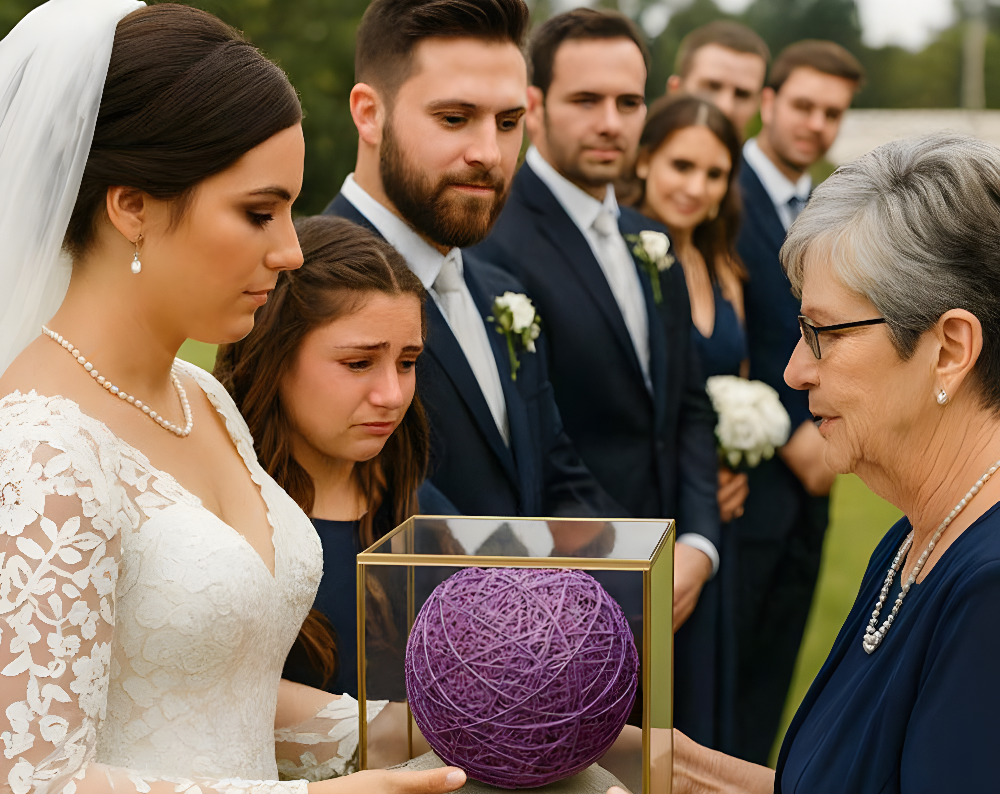The scream cut through the house like a knife through silk. I dropped the coffee mug where I stood, porcelain shattering against tile, and ran. The hallway stretched longer than it ever had before, my heart battering against my ribs with every step.
At the end of it stood Emily, my ten-year-old daughter. My Maid of Honor. She was frozen in the doorway of her bedroom, small hands clapped over her mouth, blue eyes wide with disbelief.
“Emily?” My voice trembled.
She pointed.
I followed her gaze and saw it.
The lilac dress. Or rather—what was left of it.
The floor was littered with a heap of yarn, strands twisted, loops undone with brutal precision. Not a snag, not a clumsy pull from careless hands, but deliberate destruction. The dress I had spent months crafting—each stitch crocheted in the quiet of sleepless nights, each loop a testament to patience and devotion—was gone.
Emily’s voice cracked. “Mom… why would someone do this?”
Her sobs echoed, small and sharp, as I pulled her against me. My own tears burned, but I held them back. My girl needed strength, not grief. Yet even as I cradled her, a cold, undeniable truth rose in me.
This wasn’t an accident.
This was sabotage.
Margaret.
My fiancé’s mother. Regal. Cold. Every word sharpened like glass. She had made her disdain plain from the very beginning.
At our first meeting, she looked at my hands, calloused from years of working and stitching, and arched an eyebrow. “You sew?” she asked, her tone halfway between curiosity and contempt.
“Crochet,” I corrected softly.
“How… quaint,” she said, the smile never touching her eyes.
From then on, the pattern never changed. The way she lingered on my dress choices. The way she sniffed at my cooking. The way she spoke of “family reputation,” as though I were a blemish upon it.
And when she saw Emily’s lilac dress last week, she had flinched.
“A wedding,” she said coolly, “is no place for homemade costumes.”
“It’s not a costume,” Emily said fiercely, chin lifted. “It’s special. Mom made it just for me.”
Margaret’s lips curved, but the disdain lingered. “Sentimental, yes. But these things never last.”
The words rang in my ears now as I looked at the unravelled heap on the floor. Never last.
I forced myself to breathe. The wedding was only hours away. Guests were already traveling, florists had delivered, and the cake was being set in the hall. The thought of walking down the aisle while my daughter stood in tatters made bile rise in my throat.
Emily sniffled against my shoulder. “What do I wear now?”
I tightened my hold on her. “We’ll figure it out.”
But my mind whispered the rest: She’s winning. Margaret’s winning.
Downstairs, Margaret’s voice drifted through the kitchen as if summoned by my rage. Smooth, controlled, with that undertone of superiority.
“Really, Thomas,” she said to my fiancé, “don’t you think tradition matters? This family has a name to uphold. Appearances matter. Guests will remember what they see.”
I stood hidden in the hallway, Emily clutching my hand, and listened.
Thomas sighed. “Mother, enough. She’s part of this family now.”
“Part?” Margaret’s voice sharpened. “She doesn’t know our ways. She thinks yarn and lace are substitutes for elegance. She’s dragging you into her world, not ours.”
The words landed like blows.
And suddenly, clarity cut through me like lightning.
She didn’t just dislike me. She saw me as the enemy.
I spent the next frantic hour combing through boxes, drawers, closets. Old fabric. Spare dresses. Nothing was right. Emily’s small face grew paler with every passing minute.
Then my eyes landed on the yarn basket. Not lilac. Not the perfect skeins I had chosen. But scraps. Whites, creams, soft yellows.
“Mom?” Emily asked, watching me pull out hooks and threads.
“We’re not giving up,” I said.
I crocheted like a woman possessed, hands flying, loops forming faster than I thought possible. Emily sat close, her doll on her lap, her eyes following every motion. Hours blurred into minutes. Each stitch was a defiance, a declaration that no one—not even Margaret—could erase what we had.
By the time the sun dipped and the church bells tolled, the dress was finished. Imperfect. Patchwork. A mosaic of every scrap I had left. But it was ours.
Emily twirled once before the mirror, her smile trembling but radiant. “It’s even better,” she whispered.
At the church, whispers buzzed as guests turned to watch. Emily walked ahead of me, her little patched dress glowing under the stained glass. Every uneven stitch caught the light, transforming flaw into beauty.
And in the front pew sat Margaret, lips pressed tight, eyes narrowing.
Her silence was louder than words.
When the ceremony ended and the guests filed out, Margaret cornered me near the altar.
“You embarrassed us,” she hissed, her regal mask cracking. “A ragged dress? People will talk.”
I met her gaze steadily for the first time. “Let them.”
Her eyes widened at my defiance.
“This family isn’t built on silks or reputations,” I said quietly. “It’s built on love. And if you can’t see that, then maybe it’s not me who doesn’t belong here.”
For a heartbeat, Margaret faltered. Then her chin lifted, armor snapping back into place. “We’ll see,” she said, and swept past me.
That night, long after the guests had gone and Emily slept peacefully beside her doll, I stood alone by the window. The patched dress hung across a chair, imperfect and beautiful.
Margaret’s war had begun. But she had underestimated me.
Every stitch told a story—and I had only just begun to weave mine.
